Technical writing can be challenging work. It’s no easy feat to create, maintain, and edit software documentation, considering how complex and intricate the subject matter can be.
Therefore, to facilitate the process, it’s a good idea to employ a documentation tool for technical writing. The only question is: which one?
There are many available choices, including help authoring tools, documentation platforms, and more.
The sheer number of options can be overwhelming, and it might be difficult to differentiate between them.
That’s precisely why we wrote this article—to help you choose the documentation tool that fits your needs best.
Do Your Research
The initial step to choosing any documentation tool is knowing your options. To discover that, you’ll have to do some research.
This process is often tricky, as there are many tools with similar features. Every resource aids with document creation, but how do their version controls differ? What about export options?
These are the questions you’ll have to ask—and answer—while doing research on documentation tools.
Luckily, there are resources to assist you. Just look up "documentation tools comparison", and you should see a page like this:

Source: Capterra
This screenshot is from Capterra, a SaaS directory and review platform for software solutions. The website lists countless tools, each described via ratings, a feature list, and user reviews.
That data is hugely helpful, as Capterra essentially does the investigative work for you. You already have all the facts laid out.
The user reviews are especially helpful. Here’s an example:

Source: Capterra
From this review, you’ll learn Archbee incorporates diagrams in its documentation platform, which just might be the deciding factor for some customers, depending on their needs.
However, while Capterra is helpful, it offers only bite-sized, fragmented pieces of information, as shown above. The website lacks cohesive, well-rounded explanations.
Fortunately, there’s an alternative. Plenty of articles have been written on documentation tools— long-form content that offers more in-depth, elaborate insights.
Here’s Humble Themes advertising one such article:

Source: Twitter
The article describes several documentation tools, dedicating multiple paragraphs of explanations to each. That way, you’re offered a deep-dive look into each solution’s capabilities.
However, there’s still work to do even after settling on a tool. It’s always a good idea to research the company to double-check if they’re reliable.
One Reddit user offered the following advice:

Source: Reddit
Look at the company’s release notes and feature requests, and check for regular activity.
Do company representatives address their users’ feature requests? How regularly are release notes published?
The answers to both these questions indicate how dedicated the business is to its users and how well they’ll support you.
If they seem responsive to customers and consistent with their updates, you’re on the right track. If not, it’s perhaps better to continue your research.
Consider the Documentation Tool’s Features
The features of a documentation tool are arguably its defining characteristics, seeing as they determine its capabilities.
Imagine if a tool lacked collaborative options—that solution automatically wouldn’t be suited for larger teams.
Consequently, it’s vital to consider a tool’s features when making your decision, as certain elements are non-negotiable for sophisticated documentation software.
The graph below shows such essentials:

Source: Archbee
A documentation tool should employ advanced organizational features. For example, files could be assigned tags or labels, or similar documents could be intuitively linked together.
Restricted access is also crucial, as some documents are irrelevant for certain users or departments.
Finally, customization should be a priority as well. Your users should immediately recognize your documentation as belonging to your company via its design.
While these functions are basic capabilities a documentation tool should offer, there are also additional features that would improve the user experience.
Consider the following statistic:

Source: elastic / Image: Archbee
Finding the correct documentation is often particularly time-consuming, so it’s well worth prioritizing a tool with sophisticated search functions.
If your documentation tool has quality searchability, you’ll be able to free up your employees’ time and allow them to focus on other, more important tasks.
Once users find the documents, they might have to share them with someone unaffiliated with your organization. In such situations, various export capabilities go a long way.
In other words, examine the documentation tool’s export options. Most robust tools will include the major file formats depicted below:

Source: Archbee
The two most commonly used formats are PDF and Word—your non-technical associates are likely to request them reasonably frequently.
However, the more technically minded among your colleagues will probably prefer Markdown and RTF.
The former is helpful with source code version control systems, whereas the latter transfers text between different operating systems or word processing programs.
ePub is also helpful, as this e-book file type boasts advanced support for media such as videos and audio.
Finally, TXT is useful to have on hand for easy data input into applications.
Considering their potential impact on your operations, these export features should definitely factor into your decision-making process.
Check the Tool’s Integrations
The modern workday is unimaginable without software tools.
Today’s developers are accustomed to communicating on Slack, picking up Jira tickets, and attending meetings via Zoom.
The following numbers are a testament to just how necessary such integrations are:

Source: BetterCloud / Image: Archbee
Most companies these days use around 130 SaaS apps.
Unless at least some of those apps were integrated, the productivity within these companies would suffer due to the constant app-switching, which would significantly slow down employees.
Considering the dependency and popularity of these software solutions, it would be ideal if your documentation tool could integrate with the tools your employees already use.
That way, workflows would be much faster, as the additional steps of moving between apps would be eliminated.
For example, here are some of the integrations Archbee hosts:

Source: Archbee
The Archbee-GitHub integration is an excellent example of an efficient workflow.
This integration allows you to upload content from your GitHub repository directly to your documentation platform.
Here’s how the process works:
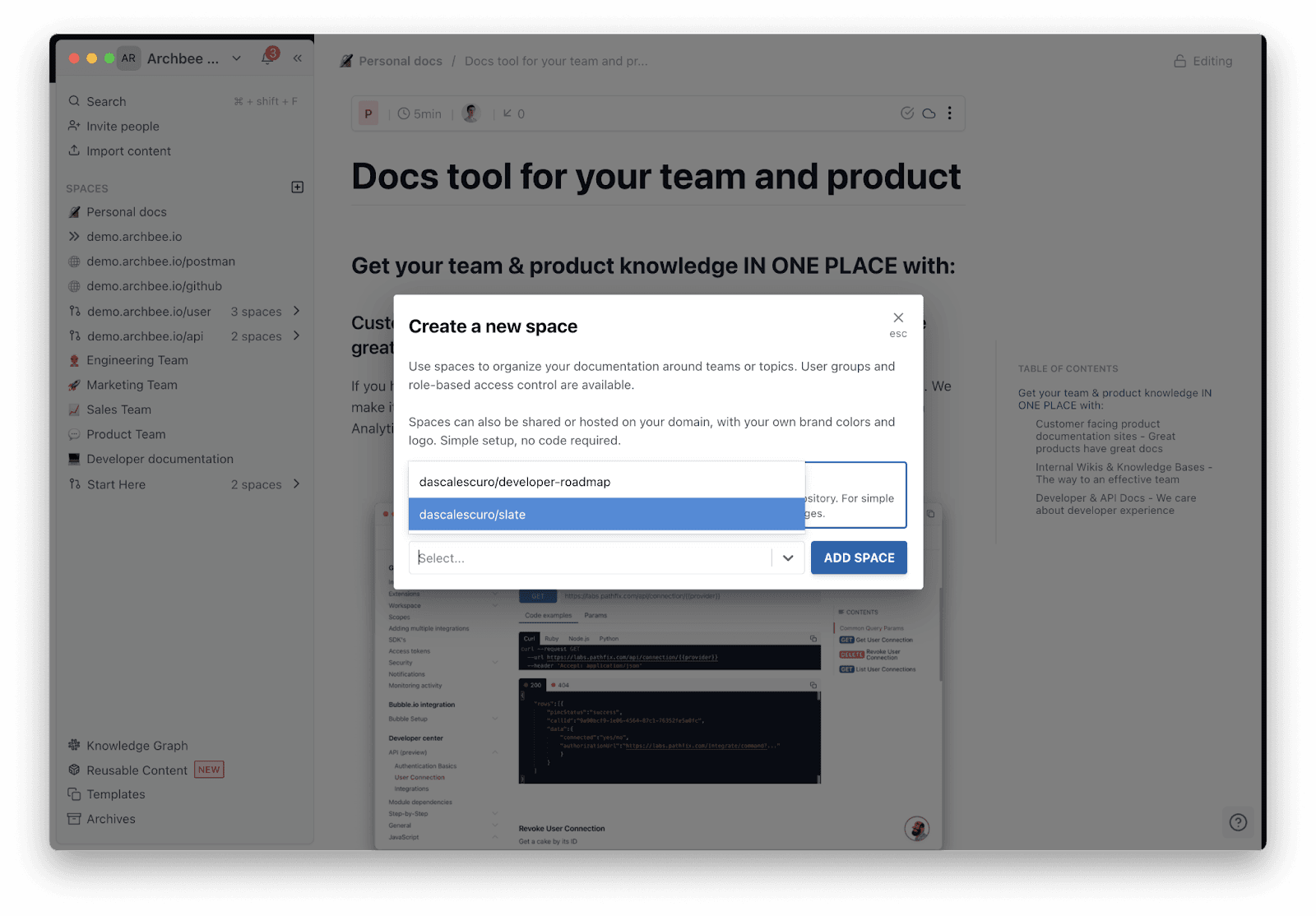
Source: Archbee
When creating a new space, you’ll have the option to select a GitHub repository, which will then automatically appear as part of your documentation.
As you can see, the process is quick, easy, and effortless. Instead of needless copy-and-pasting, everything is neatly synced.
Imagine if you had similar procedures with all your tools—your workday would immediately be more productive.
However, for documentation tools specifically, the most essential integrations are the following:
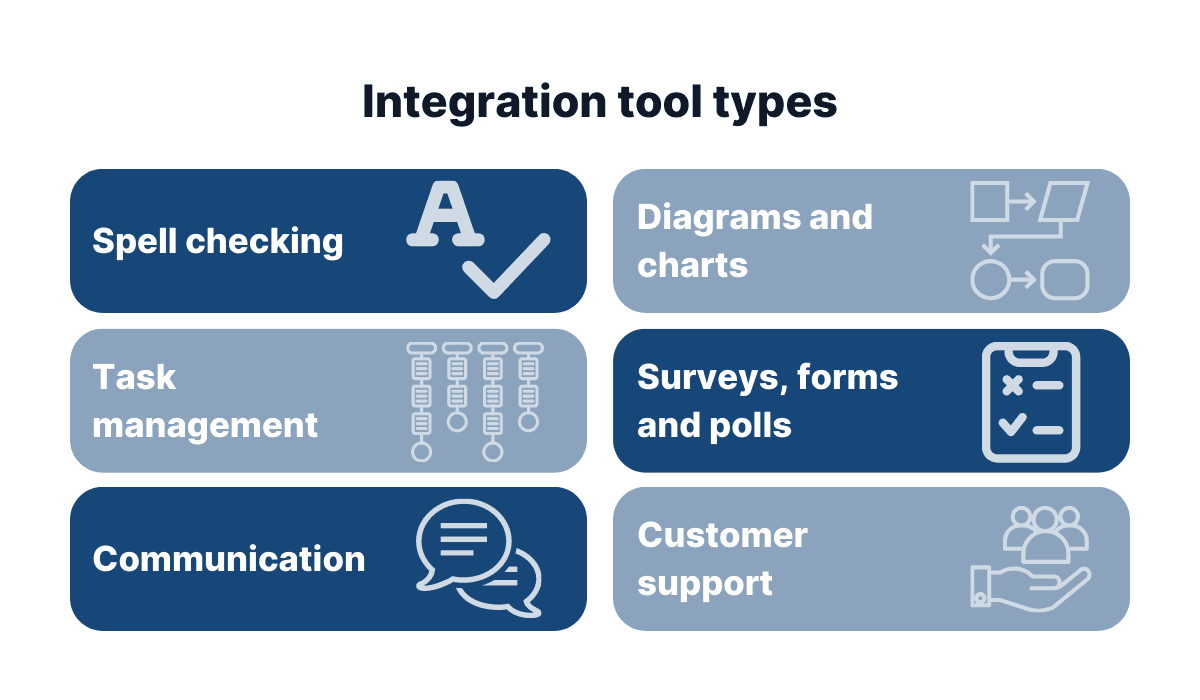
Source: Archbee
A spell-checking tool like Grammarly is a huge help, as it directly monitors your documentation’s grammar.
Task management is also practical, since you might embed Jira tickets in your documents when relevant to the topic.
If your team uses a communication tool (e.g., Slack), an integration could configure automatic messages for specific events, e.g., when a document is made public.
Content-wise, diagram and survey integrations will both likely be necessary in your documentation.
Finally, a customer support integration is also a good idea, as you could easily assist your end-users.
Ultimately, you shouldn’t work in a silo, and your documentation tool should easily consolidate with your other software.
Evaluate How Easy the Tool Is to Use
A documentation tool’s chief purpose is to facilitate document creation and management.
For this to happen, the tool itself should be easy to use. If the interface is clunky, the formatting complex, and the organization convoluted, the tool will only cause more harm than good.
As such, assessing how intuitive the tool is and how comfortably your employees can use it is vital.
In fact, there are certain areas where the tool must be easy to use to be helpful. A study recently reported the most time-consuming document-related tasks:
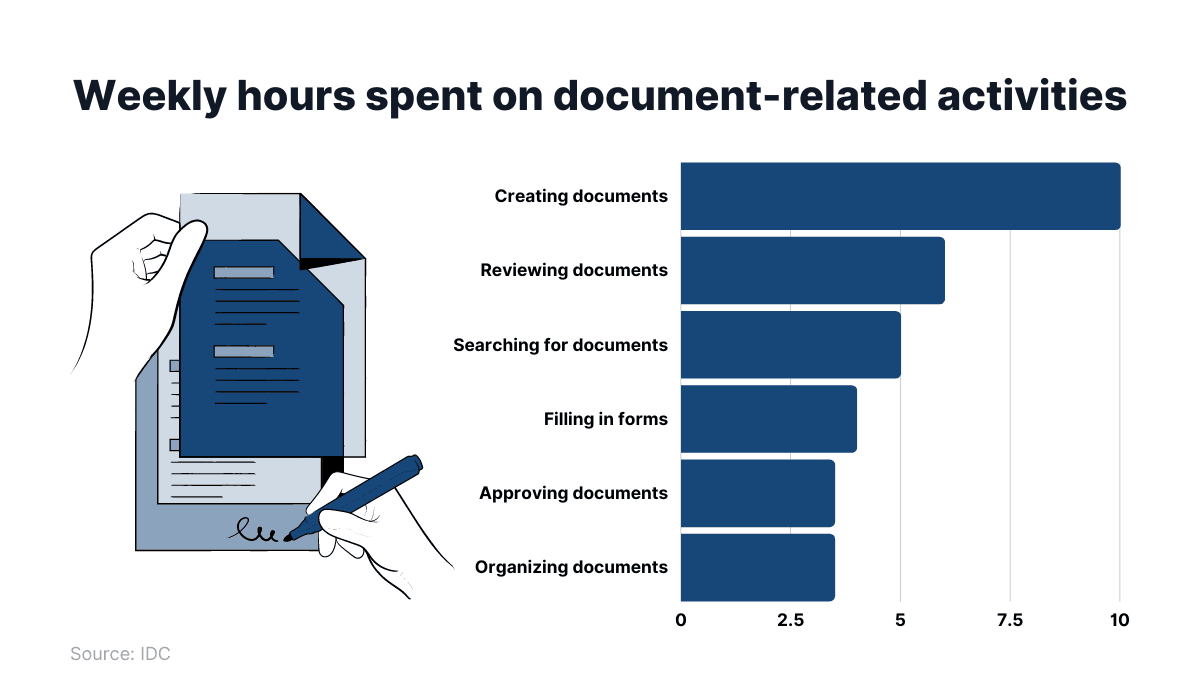
On average, employees spent ten hours per week creating documents, six hours reviewing them, and five hours searching for them.
Since these activities took the longest, it would be wise to choose a documentation tool that makes them as straightforward as possible.
Consider the document creation process—the biggest time consumer.
It would be a great advantage if your tool supported lightweight markup languages, as their syntax is extremely simple and significantly facilitates formatting.
For example, here’s some Markdown text:

Source: FFEATHERS
Now take a look at that same text written in HTML:
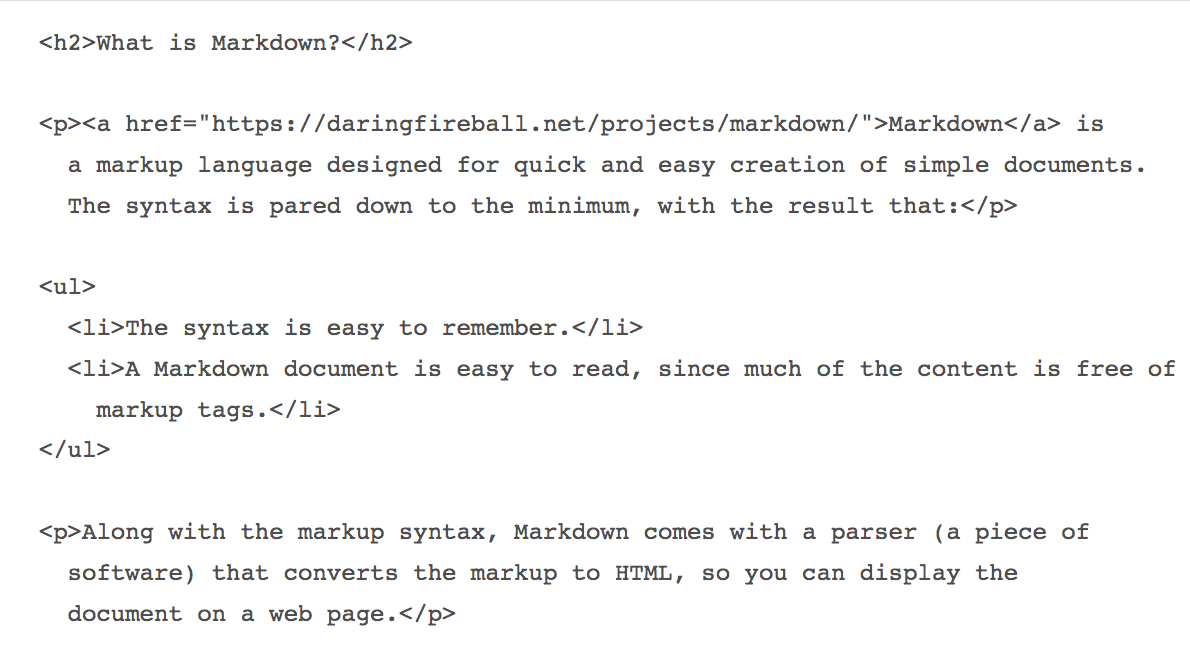
Source: FFEATHERS
It’s much quicker and easier to write in Markdown than in HTML—the syntax is clearly simpler, and the overall effect is cleaner.
As such, keep an eye out for those tools that offer Markdown, as your employees are sure to appreciate the effortless editing.
In fact, any documentation tool that employs shortcuts more broadly is sure to facilitate document creation.
Several tools often offer quick links to certain actions, similar to keyboard shortcuts.
For example, here’s what appears in Confluence after typing a slash:

Source: Software Philosopher
One keystroke opens up a multitude of options: tables, emojis, mentions, images, etc.
Instead of remembering an exact action or drag-and-drop element, the user just types that one slash symbol and selects the option he or she needs.
Archbee also employs a similar concept:
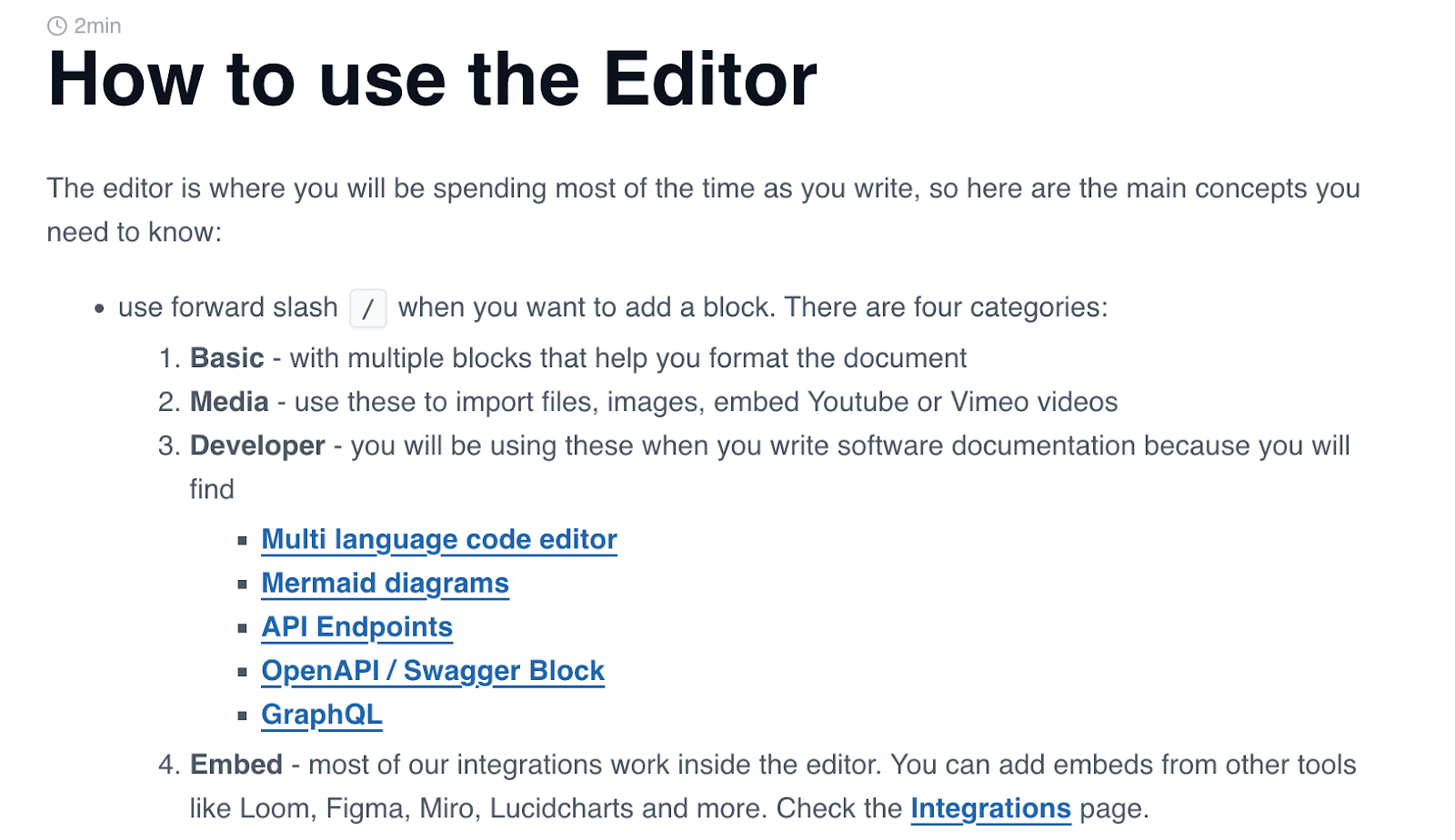
Source: Archbee
The simple slash can essentially insert almost any element users need into the documentation, making document creation effortless.
These are the types of straightforward features you want to look out for—functions that make the tool easy to use.
Consider the Cost
Unfortunately, you probably won’t find an open-source project for an advanced documentation tool.
Pricing varies depending on the resource’s capabilities, so examining the costs and estimating your total expenses is essential.
That being said, there are more factors to consider than just pricing plans.
A documentation tool is a sophisticated, high-level solution that requires some time to implement, meaning costs can quickly accumulate.
Here’s an overview of all possible fees:

Source: Archbee
The most transparent factor is the subscription price—the tool’s annual or monthly plan.
However, there can also be supportive software necessary to operate the tool. For example, you might need MS Word to create PDFs.
If you ever encounter an issue, you might need to enlist some technical assistance, which isn’t always complimentary.
Another added cost might be the training sessions; depending on the size of your organization, you may need to book quite a few sessions.
Also, double-check if the tool is web-based, as you’ll have to budget for documentation hosting.
Finally, it’s always a good idea to maintain content backup systems.
This might seem substantial, and some might balk at purchasing a documentation tool altogether. However, despite these costs, the resource is still often well worth the investment.
A study revealed the financial cost of wasting time when dealing with documentation-related activities:

The cumulative time lost searching, creating, and editing documents (and any other documentation activities) results in a financial burden, as illustrated above.
Therefore, in the long run, a documentation tool is definitely beneficial—it’s just a question of your company’s current financial situation and what tool makes sense momentarily.
However, generally speaking, it’s a worthwhile investment.
The Aberdeen Group summarized the concept well:
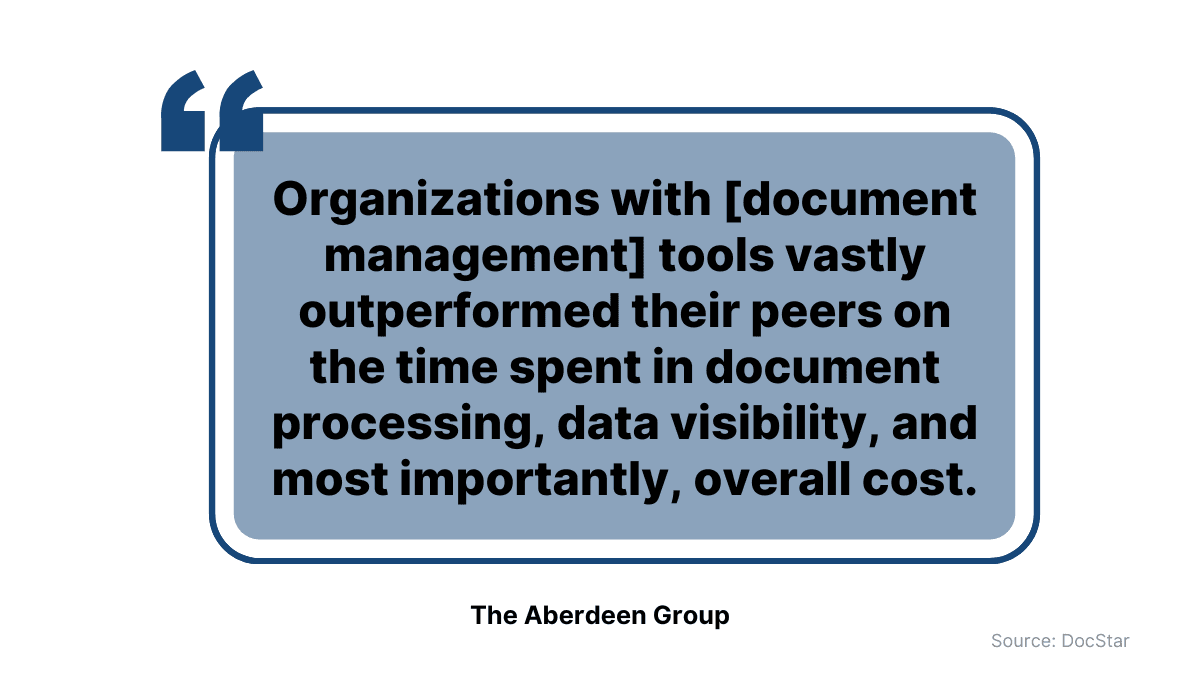
Source: DocStar / Image: Archbee
Regardless of whether the cost of a documentation tool is intimidating, the sacrifice will pay off soon.
Even if it means choosing the least expensive pricing plan instead of a more robust option, that plan is still better than no tool at all.
Simply carefully weigh your options, and choose the best documentation tool that makes sense for your budget.
Conclusion
With so many documentation tools available, selecting one specific resource can be intimidating.
After all, all these tools more-or-less perform a similar function—document creation and management—but each tool does so uniquely.
The challenge is unraveling which approach works best for you and your team and what features you require the most.
However, with quality research and sufficient attention to detail (paying attention to integrations, ease of use, and pricing), you should have no problem evaluating the correct tool for your needs.
And, if in doubt, just remember—any documentation tool is assuredly better than none.
Explore all of Archbee's features with our free 14-day trial.
Frequently Asked Questions
Begin with structured research. Clarify your needs, then explore the market and vet vendors before shortlisting options. Try this quick plan: - Define requirements: audience (internal/external), content types (APIs, how‑tos, diagrams), team size, compliance, and publishing needs. - List must‑haves vs. nice‑to‑haves: collaboration, version control, search, export formats, access controls, branding, integrations. - Scan comparison sites and in‑depth articles to map the landscape. - Read user reviews to learn real‑world pros/cons and gotchas. - Vet the vendor: check release notes cadence, how they handle feature requests, and overall responsiveness. - Shortlist 3–5 tools, run a hands‑on trial with real content, and score them against your checklist. This approach ensures you’re evaluating the right tools against the criteria that matter for your team.



